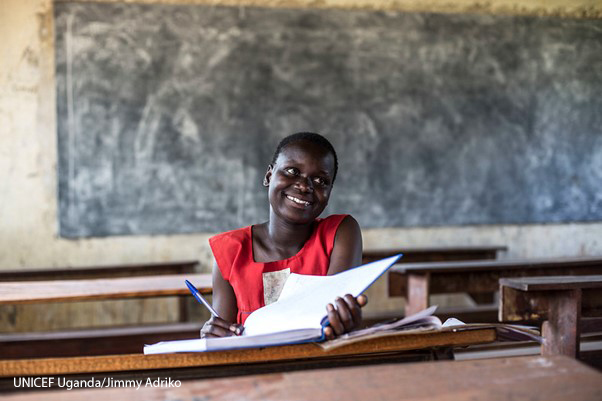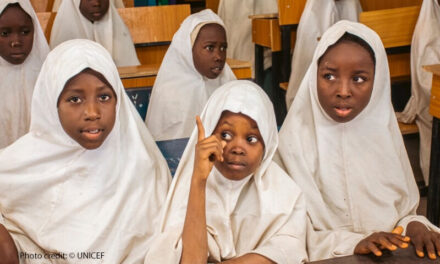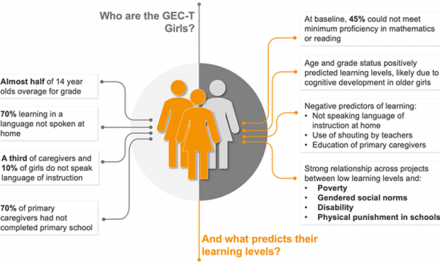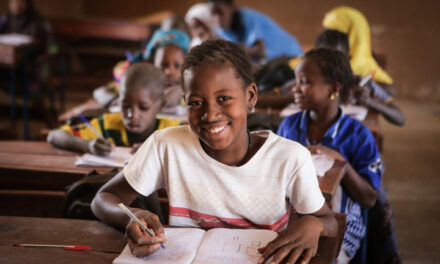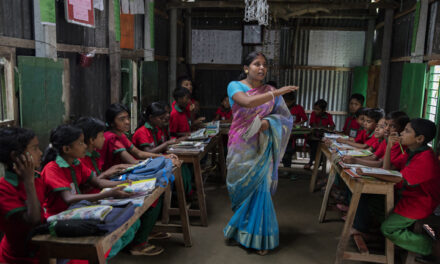This blog was published by Akuja de Garang MBE, Team Leader, Girls’ Education South Sudan. It was originally published on the Girls’ Education Challenge website on 12 October.
In 2022, we mark 10 years since International Day of the Girl Child was incepted. Whilst some improvements in access to education for girls were made over this period, significant barriers persist in quality of education, retention and completion. Progress has been thwarted by crises such as COVID-19, humanitarian emergencies, climate change and, more recently, global economic challenges. Moreover, in some communities, such as those in low-income countries, the burden of meeting essential needs such as food, health and shelter continues to overshadow decision-making in favour of girls’ education, plunging them back into the vicious cycle of poverty and cementing the root causes of gender inequity and inequality.
As I reflect on the 2022 International Day of the Girl Child theme: “Our time is now – our rights, our future”, I would like to implore girls’ education stakeholders that the time is now to make a radical shift in how we design, implement, monitor and learn from the various interventions seeking to bring about the meaningful and lasting change for girls and women across the world. Despite almost three decades of prioritising women’s and girls’ education, investments appear not to be bringing about the anticipated returns. I think that one of the reasons for this is that we are not effectively linking, synergising and effectively coordinating our efforts. Linkages among the numerous girls’ education ecosystems are vital so that we can leverage the limited resources for better efficiency, reducing wastage and narrowing the gaps.
I have participated in several events, from meetings to workshops to conferences and lectures, where the importance of stakeholder linkages is the focus, where innovative ideas were discussed, and promises for coordination were made. However, unfortunately, as soon as we vacant these forums, we tend to regress into our routines, prioritising our projects and widening the silos. Needless to say, these forums cost time and money unto themselves; time and money that could have been invested directly in the girls we seek to support. To deliver on our promises to the girls of now and in the future, we need to hold ourselves and each other accountable for every penny and every minute we spend in the name of girls’ education. Some concrete ways I think we could be accountable is by committing to strengthening linkages by making this a key performance indicator (KPI) of our projects’ results chains and personal development goals. For instance:
- Firstly, tie SMART KPIs on linkages in our project logframe, theories of change and job descriptions tied to payment by results.
- Secondly, include professional development objectives on linkages in job descriptions tied to career progression. This should explicitly include allocating and spending a percentage of our time as development practitioners on ensuring discussions on linkages happen, are implemented, assessed and learned from.
- Thirdly, ensuring linkages are included in project performance appraisals. In some cases, these project appraisals are public documents to ensure that there is full transparency and accountability towards the girls we are seeking to serve and the taxpayers who are footing the bill.
Stronger linkages on girls’ education are not only instrumental in us achieving our project-level objectives but enable us to efficiently contribute towards Sustainable Development Goal 4 (SDG 4) on improving quality education for all; SDG 5 in achieving gender equality and empower all girls and women; SDG 10 reduce inequalities within and across families, communities, and countries; and SDG 17 on building stronger strategic partnerships for inclusive, sustainable development. The time is now to be accountability-conscious and accountability-responsive for the rights of the girls we seek to serve – now and in the future.
Bibliography
Spending Better for Gender Equality in Education – How can financing be targeted to improve gender equality in education? Ubaldo, J., Pescina, C., Fry, L., & Fyles, N. (2021). UNGEI, New York.
Global education monitoring report 2020: gender report, A new generation: 25 years of efforts for gender equality in education. UNESCO, Paris, 2020.
Sustainable Development Goals. Department of Economic and Social Affairs, United Nations, 2022.

